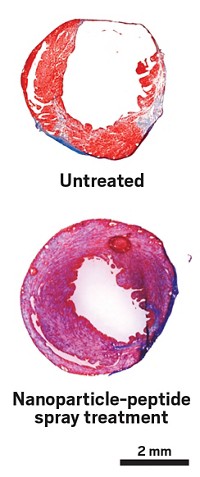Advertisement
Grab your lab coat. Let's get started
Welcome!
Welcome!
Create an account below to get 6 C&EN articles per month, receive newsletters and more - all free.
It seems this is your first time logging in online. Please enter the following information to continue.
As an ACS member you automatically get access to this site. All we need is few more details to create your reading experience.
Not you? Sign in with a different account.
Not you? Sign in with a different account.
ERROR 1
ERROR 1
ERROR 2
ERROR 2
ERROR 2
ERROR 2
ERROR 2
Password and Confirm password must match.
If you have an ACS member number, please enter it here so we can link this account to your membership. (optional)
ERROR 2
ACS values your privacy. By submitting your information, you are gaining access to C&EN and subscribing to our weekly newsletter. We use the information you provide to make your reading experience better, and we will never sell your data to third party members.
Materials
Synthetic Platelets Boost Clotting
Materials Science: Deformable microgels mimic natural platelets by stabilizing blood clots
by Celia Henry Arnaud
September 10, 2014

Platelets are specialized blood cells that participate in the clotting process the body uses to stanch bleeding. A team of researchers at Georgia Tech led by chemist L. Andrew Lyon and biomedical engineer Thomas H. Barker has designed new synthetic platelets that have the potential to boost clotting when traumatic injury overwhelms the natural clotting process (Nat. Mater. 2014, DOI: 10.1038/nmat4066).
The synthetic platelets are made of poly(N-isopropylacrylamide-co-acrylic acid) microgels with ultralow levels (< 0.5%) of cross-linking. Compared with previous synthetic platelets, they boost clotting specifically at injury sites without causing unwanted clotting elsewhere. That’s because each particle is studded with recognition motifs that bind fibrin, an insoluble protein that forms only after clotting has already started.
“In principle, we can inject our particles and they can circulate freely in the bloodstream without causing any detrimental off-target effects,” says Ashley C. Brown, a research scientist working with Barker and Lyon. “Our trigger to augment clotting is more specific than previous synthetic platelets.”
Another key feature of the new synthetic platelets is their ability to induce clot contraction, which is thought to help stabilize the clot and protect it from breaking down. This is a function of natural platelets that has not previously been seen in synthetic platelets. The researchers think these synthetic platelets can induce clot contraction because they are highly deformable, which permits more extensive engagement of the clot through the recognition motifs. That deformability is a direct result of the low level of cross-linking. “With the addition of even small amounts of cross-linker—2% cross-linking density—we inhibited clot contraction,” Brown says.
The researchers injected the synthetic platelets into rats whose femoral veins were then cut. Rats that received the synthetic platelets bled less than rats that didn’t receive them.
More data are needed on the biodistribution and clearance of the particles, says Erin Lavik, a biomedical engineer at Case Western Reserve University who is also working on synthetic platelets. “With inflexible particles, we’re limited in how large we can make them and get good clearance from uninjured tissues,” she says. “If these flexible ones avoid that issue, they could have significant application.”





Join the conversation
Contact the reporter
Submit a Letter to the Editor for publication
Engage with us on Twitter